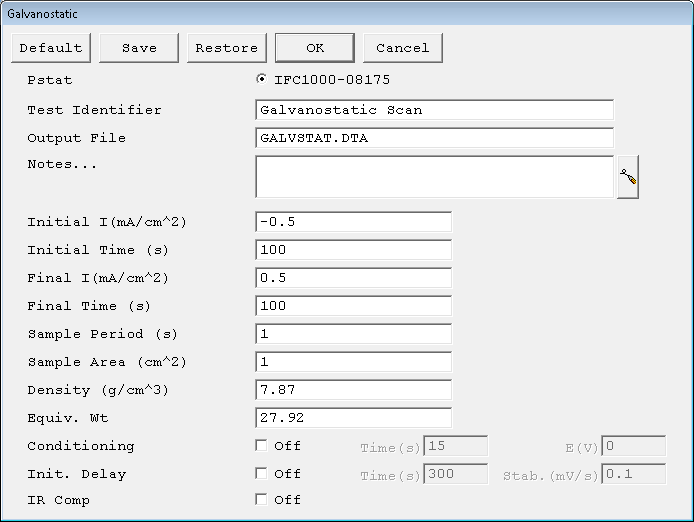Galvanostatic Setup Parameters
Here is a Galvanostatic Setup dialog box complete with its default parameters.

Current prior to the current step. The allowed range is ± the potentiostat’s rated current. Its accuracy and resolution depend on the settings of both Initial I and Final I.
The length of time that the current is at the Initial I. This is time prior to the current step (if a step is desired). The units of the Initial Time are seconds. The resolution is set by the Sample Period.
Final I
The current after the current step. The allowed range is ± the potentiostat’s rated current. Its accuracy and resolution depend on the settings of both Initial I and Final I.Both Initial I and the Final I are set using one current range on the galvanostat. Select the current range on the basis of the largest absolute current requested. For example, on a Reference 600 potentiostat if Initial I is 0.1 mA and Final I is 25 mA, the galvanostat is operated on the 60 mA range throughout the experiment. The resolution and accuracy is that of the 60 mA range.
NOTE: The most sensitive current range on your potentiostat may not be available in controlled-current experiments.
Final Time
The length of time that the current is at the Final I. This is the time after the current step. If you wish no step, enter a Final Time of zero. The units of the Final Time are seconds. The resolution is set by the Sample Period.
Sample Period
The spacing between data points. The units used for the Sample Period are seconds. The shortest Sample Period we recommend is 0.1 second. The longest Sample Period allowed is 715 seconds. The Sample Period also helps determine the Number of Points in the data curve as follows:
Number of Points = (Initial Time + Final Time) / Sample Period
The Number of Points must be less than 262 143. If you have more points, the experiment aborts just before the scan phase of the sequence. The resolution in the Initial Time and Final Time is also controlled by the Sample Period. Times that are not integer multiples of the Sample Period are rounded down. For example, if the Sample Period is set for 8 seconds, and an Initial Time of 50 seconds is requested, the actual Initial Time is 48 seconds, which is six Sample Periods.

Comments are closed.